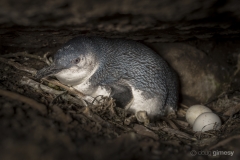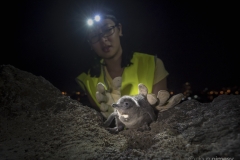Against all odds
How the worlds smallest penguin made one of Australia’s largest cities its home
Antarctica. Somewhere cold. Somewhere remote. Ask most people where you’ll find penguins in the wild, and these are probably the first things you’ll hear. But right under the noses of over 4 million Melbournians, lives a colony of the world’s smallest penguin – the little blue or fairy penguin, Eudyptula minor.
But what prompted this flightless, swimming bird to establish a breeding colony in the busy bayside destination of St Kilda – just 7km from the centre of Melbourne?
Back in1956, a 650 m long man-made rock and tunnel-filled breakwater wall was built for the Melbourne Olympics. After the athletes moved on, the penguins moved in. When exactly this happened no one is sure, but in 1974 a few sightings were recorded by the locals. Fast-forward 12 years to 1986, when a proposal to redevelop St Kilda harbour prompts Monash University water bird expert Professor Mike Cullen to visit the breakwater. The St Kilda Council offered Mike a commission to provide a report on the penguins, however he declined. Instead he embarked on a long-term study of the colony, and between 1986 and 1998, Mike conducted fortnightly trips to St Kilda Breakwater, often finishing well after midnight.
Always there to help was Neil Blake, City of Port Philip ranger. Now holding the role of Port Philip Baykeeper, Neil still cares passionately about the penguins welfare, but his role now extends to helping all the wildlife in Port Phillip Bay. When asked, “What’s the most important thing the average person can do to help look after the penguins?” Neil quickly says, “Stop the drop!” “The amount of plastic litter flowing to the Bay from streets in its catchments is a looming disaster for the Bay ecosystem. A lot of people don’t realise that suburban streets are connected to the Bay by the stormwater drains. So a ‘single-use’ plastic bottle that is dropped on a street 15 kilometres from the coast, can still impact the penguins.” He goes on add “Plastics exposed to UV light over time become brittle and break into smaller pieces that can be swallowed by fish that are food for penguins. So if you spot plastic trash on the street, wherever you are, whenever you can, pick it up and bin it!”
The Little Blue is one of 18 species of penguins and as for all penguin species, is only found in the southern hemisphere. They breed along the entire coastline of southern Australia extending from WA, SA, Victoria, Tasmania and Victoria and are also found on the coast of New Zealand and the Chatham Islands. The St Kilda colony numbers average a healthy 1,400 individuals, but compared to the 32,000 little blues found just 70kms away and outside the bay at Philip Island, this number seems small. You’ll never see 1,400 at any one time however, as the majority will be out feeding. In winter you’ll probably find about 100, with numbers tripling to 300 when rearing chicks. They will normally go to sea for 1 to 3 days, travelling only 13kms from the colony, and complete up to 800 dives per day looking for food. These dives are normally to under less than 10 meters.
Besides being only 7km form the heart of Melbourne, this is one of only a handful of penguin colonies that have established themselves next to a major city and the only penguin colony in the world that lives, feeds and forages in a bay. As Dr Tiana Preston (who completed her PhD on the foraging behaviour, diet and reproductive success of this penguin colony) explains “The fact that this species is so sensitive to human activities, both those that impact the land and the water, makes it remarkable that a colony of penguins would not only establish itself, but also grow and flourish within such a heavily used and urban environment.”
But personally, what I think is especially interesting (and concerning) is that because they only live in Port Phillip Bay, they are the only penguin colony in the world that can be impacted by drought. As Dr Preston goes on to tell me “Little penguins eat about 20% of their body weight a day, primarily feeding on small fish species such as Australian anchovy (Engraulis australis) and southern garfish (Hypohamphus melanochir). The local availability of this food source is driven by nutrients that are carried in by the nearby Yarra River. So when we have a drought, less nutrients are carried into the bay, which impacts fish stocks and subsequently the penguins, who have a greatly reduced level of breeding success.” “No where else in the world are penguins so directly impacted by drought”.
This unique and enclosed home range also makes them particularly interesting for penguin researchers. Dr Andre Chiaradia, one of the world’s leading penguin ecologists, and steering committee member of the IUCN penguin specialist group, tells me “Unlike most other penguin colonies, living only in the contained environment of the bay, allows researchers to more easily build a complete picture of what actually impacts all aspects of their lifecycle, what impacts their survival and exactly what puts them at risk.” He goes on to add, “It’s like studying an animal in a huge aquarium, but in the wild – and that’s pretty unique and special”
Like seals and some albatross, penguins fall into that unique group of animals who rely on two distinctly different habitats for their survival. Whilst most of their life is spent at sea foraging for food, an essential part of their life history happens on land – courtship, breeding and moulting. And because of this, they are also subject to two different, but equally impactful sets of human disturbances. At sea, overfishing, oil spills, entanglement in fishing line, plastic bags and other forms of litter that come into the bay can hurt them. On land, introduced predators such as dogs and foxes, as well as inappropriate contact with humans can also take its toll. And of course, being the only colony in the world impacted by drought can also have serious consequences.
But helping watch over this unique colony is the team from Earthcare St Kilda, formed in 2001. With a base of over 100 volunteers, they now work to help keep the pier free of rubbish, guide tourists at night, and continue the research started by Professor Cullen. Currently leading this research is Zoe Hogg, an extraordinary, 82-years-young retired analytical chemist, who is still an active double-bass musician, a rowing coach and also an artist. When a researcher catches a penguin it complains loudly – squawking and whacking its little flippers against the firm hands that hold it. Asking Zoe why she has – for 28 years – risked penguin wrath to weigh, tag, sex and count them, she laughs and tells me “Oh, when I moved to St Kilda I wanted to become part of the community, I wanted to do something to help out nature. I heard about this project, went along to help out a few times, and well…..I never left”.
The ability of this species to establish itself in such a unique urban environment is special in many ways. But for me, the most extraordinary thing is that many Australians have the opportunity to see wild penguins so close to home, and next to one of the most densely populated cities in Australia. Humans have a habit of changing the environment around them with little concern for the impact on other species. In many instances wildlife suffers as a consequence, but not in the case of the Little Blue penguin – not this time. By constructing something over 60 years ago for a global sporting event, we accidentally created a place where a colony of Little Blue penguins could establish themselves, thrive and call home. As Melbourne continues to expand its physical and environmental footprint, and climate change starts to bite, will they still be there in another 60 years? To be honest, I really worry, but I really hope so.
I hope that this small colony of little blue penguins, a colony that against all odds has established a home in one of Australia’s largest cities, can not only thrive, but act as a beacon – shining a light on the fact that if we want to, if we care enough, and if we pay attention, we can enjoy living with a wild species right on our door step. A species that most people if asked, would say they’d only expect to find in Antarctica, somewhere cold, or somewhere remote.
To see some videos of penguins hunting and feeding underwater in Melbourne, the following videos (not mine) give a great perspective I think. Go penguin pro , A day in the life of a penguin and Penguin feeding




















